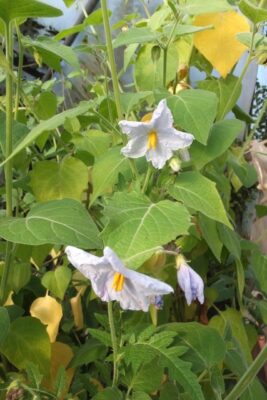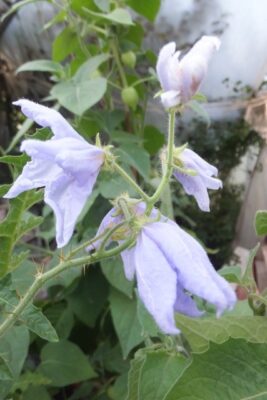
Okay, I was misled into getting seed for this greenhouse ‘delight’, from the advertisements I foolishly imagined the flavour would be delicious. From it’s parentage it looked promising; the Solanum family gives us many tasty fruits, so this ‘easy annual’ Lychee / Litchi Tomato, S. sisymbrifolium could be an excellent crop.
Coming from Brazil this likes the same warm conditions as tomatoes and can be grown alongside treated in almost exactly the same way. Start the seed with warmth in early spring, ideally in single cells or small pots, pot on twice in rich moist compost, water regularly feed lightly and finally move up to a tub or large pot. (NOT a very large tub nor plant into the border, nor feed heavily, as may then grow too much and flower less, with straggling stems flopping more than 2m every way.)
BECAUSE there is a huge piece of information not emphasised in the sales descriptions, the incredible number of excruciatingly sharp spines! This plant exudes military grade cacti spines covering almost every part right down to the papery husk half shrouding the tiny red fruits -making these hazardous to pick. A thistle seems cuddly in comparison!

If you manage to extricate a fruit these do resemble miniscule tomatoes, with all the seeds of full size ones wrapped in tough skin, decidedly disappointingly bland taste, and little sweetness. They lied! Simply not worth the effort nor space. So where the Litchi /Lychee appellation comes from is a mystery, I suspect ad-speak. Calling it Goji Tomato would be more appropriate “small not sweet not tasty fruits not heavily cropping on thorny brute of a plant”.
So why am I growing this, again? Well, the flowers are just so attractive, huge blousy tomato-like blooms in white and gorgeous light mauve. These just keep coming prolifically, week after week after month until the plant expires in winter. Simply a most reliable background display. (Snipping off any ‘tomatoes’ that do set helps blooming continue –but a prickly job barely worth doing for the extra blooms.)
Fortunately this plant is tough doing well with little attention other than watering so can be stood somewhere it needs never be gone near. In winter as this dies down suggest you use tongs to convey the remains to a bonfire not your compost in case any of those spines may come through.


